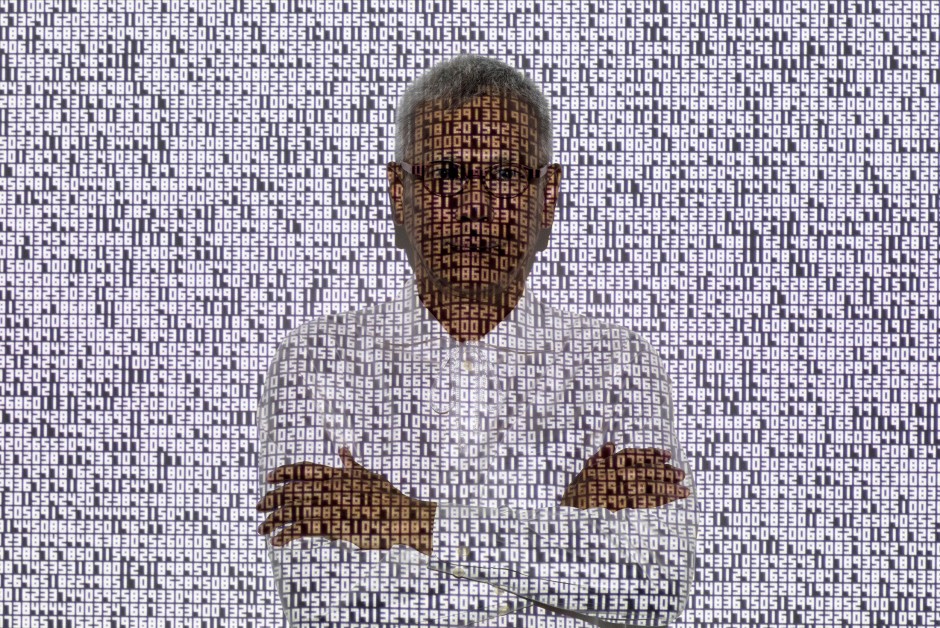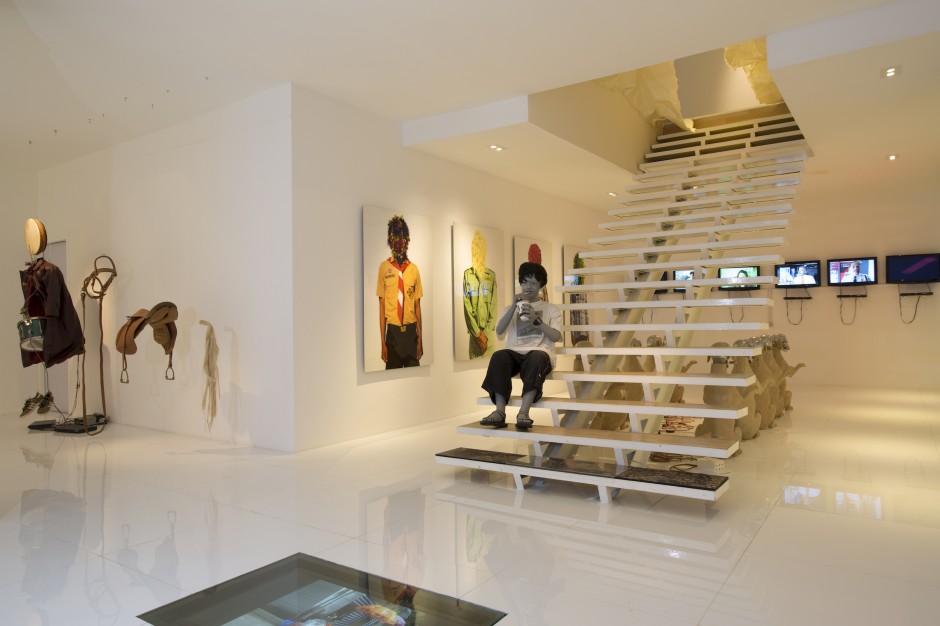“The biggest challenge of any art collector is to find out how people in the future will describe the era in which we currently live.” Stemmed from this thinking, Wiyu Wahono has built an art collection that acts as powerful tools and sources of knowledge for future generations to capture the spirit of our time. His collection stretches across all media: from bioart, light art, sound art, to performance art, scanography, audio-visual installations, etc.
Born and raised in Indonesia and then lived in Germany for 20 years, Wiyu Wahono has shared with Larry’s List how his collection reflects his background as a third-culture kid, the experience of presenting his art collection in Liechtenstein National Museum and then around the globe, what artworks he displays in office instead of at home, and his never-revealed-before wish list.

What made you want to start collecting art? What is the main motivation behind your collecting?
The critical moment I was young and backpacking through Europe, I was in Venice, and the Peggy Guggenheim Collection was and still is a must-see destination. During my visit, I stood looking at early paintings by Jackson Pollock, and I found the works displeasing and ugly. I wondered why unattractive paintings deserved to be exhibited in such a prestigious museum. My art collecting is a journey of finding answers to this question. It was only later did I realize that the method of my collecting acts as a “witness of time” because when so few Indonesian collectors collect new media art, the pieces I acquire will stand the test of time and act as powerful tools and sources of knowledge for future generations of people seeking to capture the spirit of our time.
When did you fall in love with a piece of art? What was it?
In early 1980s, I visited the Bauhaus Archive Museum of Design in West Berlin and fell in love with a painting by Hungarian painter and photographer, László Moholy-Nagy, titled Konstruktion Z1 (1922-1923).

What is your focus regarding the artists in your collection? Are you more interested in emerging or renowned artists?
Whether an artist is emerging or renowned matters little to me, as long as the piece of art fits coherently into my collection, I will strive to acquire it; but most of the artists in my collection are emerging.
Why are you particularly interested in artists who challenge the traditional straitjackets?
In the last century, art has been placed under severe boundaries and confined by definitions, which explains the extensive exploration of the question “what is art?”, for example, by Marcel Duchamp, Joseph Beuys, to name a few. Today, more and more artists have the freedom to express any ideas, create any works, and choose whichever medium they wish to create art. Everything can be art, and as a contemporary art collector, this freedom is something I want to celebrate with everyone. If artists have the freedom to use whichever medium to express their ideas, using traditional straightjacket methods is a pity, which explains why I collect bioart, light art, sound art, performance art, scanography, audio-visual installations, that challenge the traditional mediums of painting and sculpture.

You also talk much about ‘zeitgeist’. Why is it important to an art collection? How does it influence your decision to collect a work or not?
A good artwork acts as a visual reflection of an era, and every era has its corresponding spirit. The biggest challenge of any art collector is to find out how people in the future will describe the era in which we currently live. This retrospective view is why I collect pieces of art which conform to our zeitgeist.

How has your multi-cultural background, including the experience of living and being educated in Germany, influenced your art collecting practice? How does your collection reflect that?
It is true that art collectors collect art which speaks directly to their lived experience. In my particular case, being a third-culture kid, who grew up in a culture different than my parents’, has driven my interest in exploring questions surrounding identity. My parents were immigrants from China, but I was born and raised in Indonesia. I then moved and lived in Germany for 20 years. This experience has shaped how I see the world and my place within it, who I am, and questions about my identity influence my art collecting practice.
With globalization accelerating the movement of people around the world, third-culture kids have become commonplace and represent this idea of the largest “floating tribe” of people who have no allegiance to any particular nation on earth. This large and growing group of people has brought the issue of identity to the centre of discussion. Artworks dealing with the question of identity has appealed to me and is reflected in my collection.
What was the first and the latest artwork you have collected?
The first artwork I collected was a painting by Indonesian painter and sculptor, Teguh Ostenrik, titled Kipas Biru (1999), depicting a human face wearing a mask. The latest artwork was an installation by Indonesian artist, Deni Ramdani, titled 0 degree (2017), which features a suspended transparent plastic bag, filled with live fish with water dripping over a pile of soil.

Where do you display your collection?
I display part of my collection in my office and part of it at home.
How are those works in your office different from those displayed at your home?
The artworks displayed in my home have to go through my wife and two children; sometimes the pieces I acquire get vetoed out of being displayed at home. The artworks in my office are my favorites, and I don’t need to compromise. I have the fondness for artworks that neither please the eyes nor the soul. When my children were still toddlers, I couldn’t display artworks which were too scary at home.

How was the experience of presenting your art collection publicly in Liechtenstein National Museum? And where else have you exhibited your collection?
I felt so honoured to have got the opportunity to exhibit 30 artworks from my collection in a national museum. I was ecstatic because I could share the joy in collecting contemporary art with the wider European public. It was also informative for me to learn more about how Liechtenstein National Museum displayed the pieces in my collection, such as technical equipments like lighting.
Besides, the show in the Liechtenstein National Museum of selected works from my collection have been exhibited 13 times around the world, in Indonesia, Singapore, Hong Kong, Korea, Japan, Europe, and the USA.

You read and research widely about art. How does that influence your collecting art? What do you read daily in art?
Most collectors change their taste along with the knowledge they acquire, their taste informs their judgement and their judgement improves and becomes more refined as they read more books. Reading books about art theory informs my practice, and once I finish reading a book, I reflect on whether I need to adjust my art collecting practice based on new information provided to me by different thinkers. I find books by Arthur Danto most informative.

Is there any kind of artwork that can make you write a cheque without any consideration?
I am not an impulse buyer, and I need time to digest an artwork even when I see one I really like. This distance is important for me to analyze it. If I see an artwork I really like, I put it on my wish list. Some of them remains, some of them have been removed after further consideration.
So what are on your wish list now?
I’ve been asked many times about this, but I told them it’s a secret. But today, I can reveal it (at least some of them):
Shirin Neshat, Turbulent, 1998 (I don’t know whether I still can get it one day); He Yunchang, One Meter Democracy, 2010; Hicham Berrada, Presage Tranche, 2015 and many other more.

You are regarded as ‘Indonesia’s most experimental and intellectual collector’. What do you think about it? How else would you describe yourself as a collector?
My collection is surely different from most other collectors because of the cutting-edge pieces I collect. I also love to share my knowledge with other people. However, how other people choose to perceive me, it is up to them. I am okay with it.
What is your advice to young and fresh collectors?
Buy the first artwork that they like. Don’t think too much! After buying the first artwork, they will feel the excitement of being a collector.
After that, see as many artworks as they can, by going to contemporary art museums, biennales, art fairs, etc, and read contemporary art books.

Can you name three Indonesian artists who should be on our radar?
FX Harsono, Jompet Kuswidananto, Tintin Wulia.
What are you especially excited about in regard to art in the next 12 months?
Virtual reality art.
A selection of artists Wiyu collects:
Angki Purbandono
Araya Rasdjarmrearnsook
Eddy Susanto
Eduardo Kac
Shirin Neshat
By Ricko Leung





